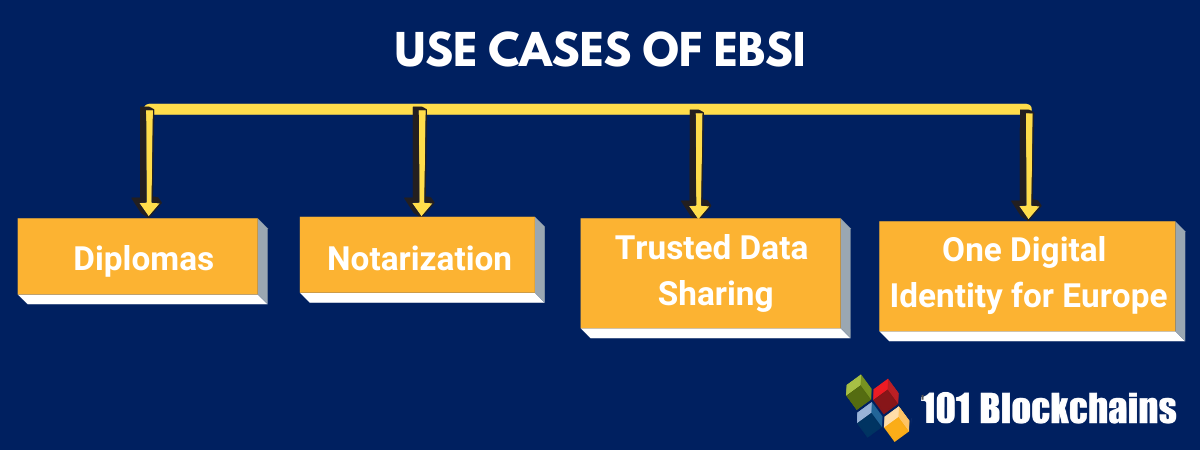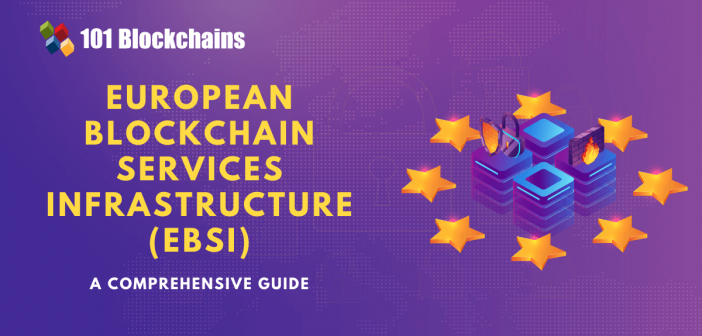The crypto world is gaining popularity beyond bounds all over the world. So, many people are interested in discovering the potential of the underlying blockchain technology beneath the crypto world. As of now, many blockchain-based projects across different industries have pointed out possibilities for the large-scale adoption of blockchain technology. The EBSI is one such blockchain project which has gained attention in recent times.
It is basically a new initiative by the European Commission for delivering a wide assortment of cross-border digital public services. So, it has inevitably caught the attention of many people all over the world, especially crypto and blockchain enthusiasts. The following discussion dives into a deep understanding of all the fundamentals of EBSI, starting from its definition and use cases alongside its value for blockchain adoption.
Build your identity as a certified blockchain expert with 101 Blockchains’ Blockchain Certifications designed to provide enhanced career prospects.
Road to the Development of EBSI
The first thing you should know before the definition of EBSI blockchain must be the timeline leading to its formation. It is interesting to note that the origins of EBSI stretch back to 2018. During this time, the EU Member States, some countries from the European Economic Area such as Liechtenstein and Norway, and the European Commission entered into a collaboration for building the European Blockchain Partnership or EBP. The EBP focused on tapping the massive potential of blockchain technology alongside empowering cooperation in delivering a wide assortment of cross-border digital public services.
The primary objective of the EBP was one of the first factors which established the foundation for EBSI. At the same time, the member states in EBP also focused on the inclusion of companies, blockchain community, and academia for their decision-making ventures. Some of the institutions which handled these responsibilities included the International Association of Trusted Blockchain Applications (INATBA) and the European Union Blockchain Observatory and Forum.
European Blockchain Services Infrastructure
The European Blockchain Services Infrastructure is an innovative, flagship initiative by the European Commission. The unique highlight of EBSI is that it is the first blockchain infrastructure implemented throughout the EU for enabling the accessibility of public services to European citizens. It would also focus on encouraging the trustworthiness of public services for European citizens. Some of the core principles underlying the initiative by the European Commission include,
- Working for the public good
- Data compatibility
- Transparent governance
- Compliance with relevant EU regulations like eIDAS and GDPR regulations
- Open-source software
- Support for high scalability
- Energy efficiency without using Proof of Work consensus
The answer to ‘what is EBSI blockchain?’ shows that it is a common, shared, and open public infrastructure. The objective of the infrastructure is to offer and support and secure ecosystem with interoperability to ensure development, launch, and operations of digital services in the public sector throughout the EU without border restrictions. Most importantly, the infrastructure would abide by the European values of green credentials and data sovereignty. It also emphasizes tackling global issues like supply chain corruption and climate change.
The EBSI blockchain could work on delivering public services with considerable levels of scalability, interoperability, better throughput, and service continuity. In addition, it would also deliver prolific assurance of the highest possible levels of privacy and security. As a result, EBSI could enable public administration and the related ecosystems for easier information verification and improving trustworthiness of services. As of now, the European Commission plans to implement the infrastructure within a gap of 3 years.
Curious to learn about blockchain implementation and strategy for managing your blockchain projects? Enroll Now in Blockchain Technology – Implementation And Strategy Course!
Architecture of EBSI Blockchain
The next important factor in understanding the European Blockchain Services Infrastructure points out its architecture. You should note that the infrastructure has been developed in the form of a public permissioned blockchain. The network nodes would be under the management of the European Commission, including the 27 EU members and the individual members in the European Blockchain Partnership in the individual regions.
As of now, the peer-to-peer network of the infrastructure includes 36 live production nodes, with 11 more in the setup phase. However, it is too soon to pass judgment on the infrastructure as it would take almost three to five years to pass from concept to deployment. Over the course of its development, the EBP aims to transform from an investment fund to a complete development investment platform with funding in the amount of €1-2 billion.
In the most basic sense, you can develop a better understanding of ‘what is EBSI blockchain?’ by identifying the layers. The infrastructure features three distinct layers which have unique functions. Here is an outline of the three layers you can find in the EBSI architecture.
- The base layer would include the basic infrastructure alongside other elements such as the necessary storage, blockchain, and connectivity.
- The core services layer would serve as an essential element for enabling all EBSI-related use cases and applications.
- Additional layers in the architecture deal particularly with certain use cases and applications.
Start learning Blockchain with World’s first Blockchain Skill Paths with quality resources tailored by industry experts Now!
Use Cases of EBSI

The understanding of architecture would obviously push towards the next basic factor in introduction to the European Blockchain Services Infrastructure. Interestingly, the iterative development of the infrastructure favors the emphasis on a selected assortment of use cases. Over the course of time, the use cases of EBSI would expand further. Some of the notable initial use cases of the infrastructure include the following.
-
Diplomas
EBSI blockchain can put the control of managing education credentials in the hands of the credential holders. Citizens could easily manage their education credentials while slashing verification costs by huge margins. At the same time, the use of the new infrastructure for allocating and managing diplomas also leverages blockchain for improving trust in the authenticity of credentials.
-
Notarization
Blockchain could also serve as a crucial booster for developing trustworthy digital audit trails in agreements. Furthermore, you would not need intermediaries with the use of EBSI for the automation of compliance evaluations in time-sensitive processes. The infrastructure could also provide better flexibility for proving data integrity.
Start your blockchain journey Now with the Enterprise Blockchains Fundamentals – Free Course!
-
Trusted Data Sharing
You could also find another interesting use case of European Blockchain Services Infrastructure with functionalities for trusted data sharing. Blockchain technology can help secure data sharing among authorities in the EU. The infrastructure can prove useful for sharing sensitive data such as IOSS VAT identification numbers. Furthermore, it can also support imports of one-stop shops among the tax and customs authorities.
-
One Digital Identity for Europe
Another striking use case associated with the EBSI blockchain refers to the creation of a generic digital identity capability. Users could create and control their identities throughout borders without having to depend on centralized authorities. At the same time, the infrastructure could also facilitate compliance with the eIDAS regulatory precedents.
The other use cases under development right now could also play a crucial role in expanding the infrastructure further. The three most promising use cases of EBSI which could gain recognition in the future include,
- The facility of management for cross-border and cross-authority processes for demanding asylum.
- Use of European social security numbers for enabling access to welfare services without any border restrictions.
- Small and medium-sized enterprise financing by leveraging blockchain.
It is also important to note that the future of European Blockchain Services Infrastructure would bring in more private companies. So, it can potentially offer new opportunities for saving money and improving efficiency in transactions and interactions among the public and private sectors.
Benefits of the EBSI Blockchain
The most significant aspect in an introduction to EBSI would obviously take you to the benefits of the new infrastructure. As a matter of fact, it could present distinct benefits for EU citizens, national administrations as well as European Union institutions.
- EU citizens could get the opportunity for easier and secure cross-border transactions with public services.
- National administrations could explore possibilities for simplification of administrative processes alongside improving efficiency and infusing trust among citizens.
- European Union Institutions could also discover the value of simpler administrative processes with the EBSI blockchain. At the same time, they could also address the concerns of regulatory compliance alongside improving efficiency in the delivery of cross-border public services.
Interestingly, European Blockchain Services Infrastructure also presents a lot of promising benefits in general such as,
- Simpler administrative processes with reduced efforts in information verification and audits and decentralized trust services.
- Improved trust with external stakeholders due to smart contract transparency and use of EBSI wallet with Self Sovereign Identity (SSI) and Verifiable Credentials.
- Better efficiency through improved security, resilience, and performance.
- Enhanced transparency alongside traceability of transactions and data on the infrastructure.
- Improved regulatory compliance with specific attention to eIDAS and GDPR.
- Better data harmonization with the easy identification of anomalies and distributed ledger technologies.
Get familiar with the terms related to blockchain with Blockchain Basics Flashcards.
Final Words
On a concluding note, it is quite clear that EBSI is a favorable initiative tailored for the public interests. The blockchain-based infrastructure could simplify access to public services without border restrictions throughout the EU. With the backing of the European Commission and EU member states, the EBSI blockchain is shaping up formidably.
Most importantly, the proven use cases of the infrastructure in diplomas, trusted data sharing, notarization, and cross-border digital identity showcase its potential clearly. The adoption of the infrastructure would present distinct value advantages for citizens, member states, and institutions. Learn more about the European Blockchain Services Infrastructure right now!
*Disclaimer: The article should not be taken as, and is not intended to provide any investment advice. Claims made in this article do not constitute investment advice and should not be taken as such. 101 Blockchains shall not be responsible for any loss sustained by any person who relies on this article. Do your own research!








